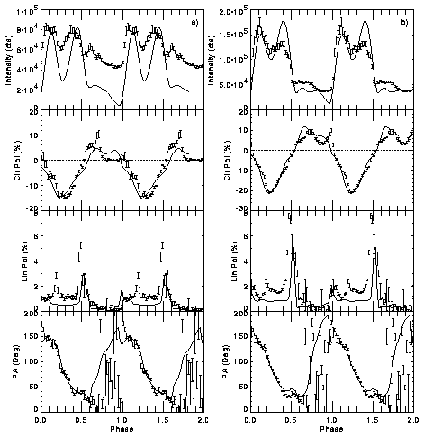Magnetic CVs consist of a dwarf
secondary star and a white dwarf primary. The white dwarf accretes
material from the secondary through Roche lobe overflow. This occurs
in the form of an accretion stream, which in the case of the strongly
magnetic AM Her systems, impacts directly onto the surface of the
white dwarf. There are a number of emission processes which occur, the
most important being X-ray and
cyclotron emission. The later type of emission is due to electrons
spiralling down the magnetic field lines of the white dwarf.
The fact that cyclotron emission from AM Her systems is strongly
polarised (up to 10's of percent) makes polarimetric observations of
magnetic CVs an important diagnostic tool. From such observations we
can obtain important system parameters, such as the binary system
inclination and the offset between the spin and magnetic axes of the
white dwarf.
It is worth re-capping some basic properties of polarised
light. Polarised light is made up of two components - one linearly
polarised, the other circularly polarised. The linear component makes
a maximum contribution when the magnetic field is viewed roughly
perpendicular to the line of sight, while the circular component peaks
when the magnetic field is parallel to the line of sight.
At MSSL we have obtained a number of polarimetry data sets over
the years. As an example of data from an AM Her system, we show
polarimetry data of RE1844-74 taken
using the Anglo
Australian Telescope

The left hand panel of the above figure shows the polarisation data
through a broad green filter, while the right hand panel shows the red
band data. From top to bottom, it shows the intensity data, circular
polarisation, linear polarisation and its position angle. Initially
workers modelled polarisation curves assuming that the accretion
regions on the surface of the white dwarf were small and circular in
shape. As higher quality data became available it was found that to
model the curves succesfully, the accretion regions were required to
be long thin arcs. The solid lines show the best fit to the
data. These fits enabled us to obtain the system geometry and also the
magnetic field strength at both accretion regions. (See Ramsay et al 1996 for the full
paper on RE1844-74).
Up until now it has been a rather laborious task to fit models to
polarisation data. The model parameters have had to be modified by
`hand'. Recently, however, several members of the CV group (Potter,
Hakala & Cropper) have used genetic alogrithims to obtain fits to the
polarisation data. These methods are described in our page
on one particular application of Genetic Alogrithms.
MSSL home pages:
Written by Gavin Ramsay:
gtbr@mssl.ucl.ac.uk
Last up-date: 23 July 1997